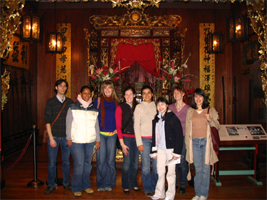Hi, my name is Stephanie Cruz. As a junior majoring in Anthropological sciences, I thought that taking CASA 103 the Laboratory Methods class would be beneficial in helping me learn skills applicable to the field and lab, but I had no idea that this class would also teach me so much about local history. Through CASA 103 I’ve grown better acquainted with the area in the short span of four weeks than I had in almost two and a half years. Much of this is due to our background reading assigned to us each week on some aspect of Chinatown life, as well as guest speakers and a field trip to modern day Market Street.
Most recently we were graciously visited by Connie Young Yu, the author of Chinatown, San Jose, USA. Ms. Young Yu recounted stories from her book and also from her own childhood and background. She described the Chinese immigrant experience using examples which her own grandparents struggled through, like finding jobs and very explicit threats. Ms Young Yu also mentioned the imbedded prejudices in place against Asians as late as the 1930s, when her father was ostracized from finding a job, even with a Stanford engineering degree. Later on in the week, the class ventured into San Jose. We visited History Park San Jose and the Ng Shing Gung, which means “Temple of Five Gods”, a historic recreation of the Heinlenville cultural and religious center built in 1888. Here we met Monica Tucker, who gave us the tour across the temple and explained how the various artifacts of the collection were incorporated into exhibit. We saw what people previous to us had cleaned, sorted, and catalogued presented to us in neat glass cases, which gave me a real sense as to how we were contributing to Chinese History commemoration.
Featured Artifact
The artifact of the week or artifacts of the week as the case may be, are three marbles (artifacts 85-32-24-111, 85-31-24-108, and 85-31-24-107). I chose these because I thought they represented a part of community life that is often overlooked: children at play. While I may not be 100% sure that these marbles belonged to children, they do suggest it. In particular I thought these marbles exemplified the cautious care and attention to detail that many artifacts in the collection exhibit. In particular artifact 85-32-24-111 which has small leaf decorations is especially appealing, not just as a toy but as an example of careful craftsmanship.






